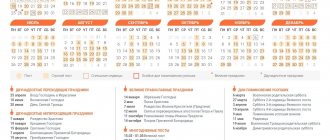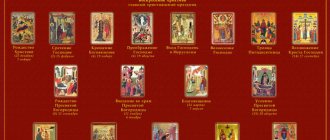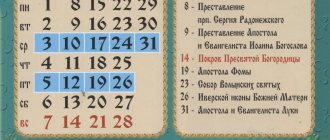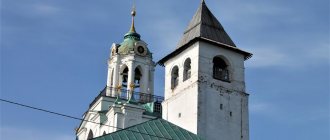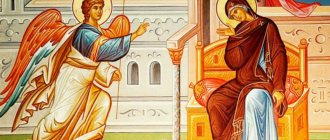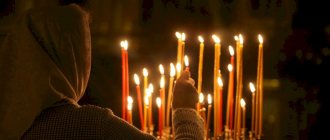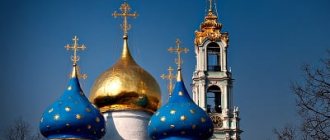What is the twelfth holiday?
This name arose from the Slavic “twelve” - that is, “twelve”. In the church classification, these holidays are the most significant after Easter, and they are celebrated with special celebration. All twelve holidays are dedicated to the events of the earthly life of Jesus Christ and the Blessed Virgin Mary. In the Typicon (the statutory document of the Church regulating the rules and procedure for performing divine services) they are marked with a red cross in a full circle, which also emphasizes their significance.
There are dates relating to the twelve holidays, such as pre-celebrations, post-celebrations and giving . In the first case, believers prepare for a great event and begin to celebrate in advance. In secular tradition, by the way, there is an unspoken sign that it is impossible to celebrate the holiday in advance, as well as to congratulate it. In Orthodoxy, the forefeast day prepares a person for celebration, reminds him of events, and helps him tune himself into a spiritual wave that he may have lost due to being busy with everyday affairs.
After-feast is a continuation of the holiday, which usually occurs after a few days. And giving , as you guessed, is a “farewell” to the holiday until its next occurrence. The spread of celebrations over time, even if a person cannot always attend the service, thanks to the presence of a calendar, helps one to remember and, together with the entire Church, live through the events of the holiday, think about one’s soul, the meaning of life, and mentally compare oneself with the “heroes” of memorable dates. This allows the believer to engage in spiritual self-development, because comparison with a saint will certainly show his own imperfection.
What Orthodox holidays belong to the twelfths?
Here they are, many of them are probably familiar to you:
- Nativity of the Blessed Virgin Mary
- Exaltation of the Holy Cross
- Presentation of the Blessed Virgin Mary into the Temple
- Nativity
- Epiphany
- Presentation of the Lord
- Annunciation of the Blessed Virgin Mary
- Entry of the Lord into Jerusalem
- Ascension of the Lord
- Day of the Holy Trinity
- Transfiguration
- Dormition of the Blessed Virgin Mary.
Twelfth Orthodox holidays: what they are and how to celebrate them
It’s easy to get confused in the huge variety of holidays in the Orthodox calendar. In Orthodoxy, holidays are not simply divided into large and small. Among the major holidays there is a special type - the Twelveth.
There are major twelve holidays, great, medium, small, days of remembrance (daily). Each of them is important in its own way, but at the head of everything is only one holiday, which does not belong to any of the groups - Easter.
Features of the twelve holidays and how they are celebrated
There are only twelve of them. Translated, the word “twelfth” means “twelfth”. Every year these holidays can be celebrated on the same day, or they can be moving, that is, changing their date.
These are the largest and most important holidays that reflect the very course of life in the history of Jesus Christ and the Virgin Mary. These holidays educate us, they are designed to inspire believers. They are a reminder that the Mother of God and the Messiah were ordinary people who were entrusted with a special mission to save humanity from original sin.
The importance of the holiday is determined by the number of pre-holiday days, that is, preparatory days. Also, the twelve holidays have days of after-celebration and continuation. Everything ends in giving.
Such holidays are celebrated in a special way. Firstly, you can’t work on such days. You can and should go to work, but you shouldn’t do anything beyond measure. Work in the garden and cleaning are prohibited.
Such days are spent in family, in church and in prayer. It is recommended to gather a modest feast, which should be attended by all your family and friends.
List of twelve holidays
Nativity. This is the largest twelfth holiday, which has a fixed date of January 7. It follows immediately after the end of the Nativity Fast, one of the strictest of the year. Many people believe that the church calendar begins with the Nativity of Christ, but this is not so.
Nativity of the Virgin Mary. The Virgin Mary started everything, so the first of the twelve biggest holidays on the calendar is dedicated to her. September 21 marks the first holiday after the church new year.
Exaltation of the Holy Cross. This holiday is celebrated every year on September 27th. This is the second twelfth holiday in the church calendar. Dedicated to finding the cross on which Christ was crucified. On this day they read the “symbol of faith” prayer and give crosses to each other.
Presentation of the Virgin Mary into the temple. This is a very important event, because on this day they remember how the Virgin Mary was handed over to the hands of the Lord. Her father and mother, Joachim and Anna, gave their daughter at the age of three to the care of the church in order to fulfill an agreement with God, who promised to give them a daughter in exchange for their agreeing to hand her over to the church. The holiday is celebrated on December 4th.
Baptism. Baptism is also called Epiphany. On this day, the baptism of Christ in the Jordan River by John the Baptist is remembered, holy water is collected in churches, and swimming is carried out in the ice hole. The four days of the forefeast indicate that this is the second most important day after the Nativity of Christ. Epiphany is celebrated on January 19 every year.
Meeting of the Lord. “Meeting” is translated as “meeting.” This is a holiday dedicated to the bringing of the baby Jesus Christ to the Jewish temple to perform the rite of initiation into the faith. This was the first time the world met Christ, which is why the holiday was named that way. Celebrated on February 15th.
Annunciation of the Blessed Virgin Mary. The good news was brought to Mary by the Angel of the Lord. He said that she would have to give birth to a son, who would have to accept death for human sins and save humanity from original sin. The date of the holiday is April 7.
Entry of the Lord into Jerusalem. This holiday is celebrated on the last Sunday before Easter, therefore it is movable. On this day, people solemnly greeted Christ, thinking that the new king of the Jews had arrived. An alternative name for the holiday is Palm Sunday.
Ascension of the Lord. Celebrated on the fortieth day after Easter, Thursday. This moving holiday symbolizes the ascension of Christ to Heaven. His Earthly affairs were completed - he had to take his place next to the Father in Paradise. That is why it is believed that the souls of the dead walk among us on Earth for another forty days.
Day of the Holy Trinity. It is celebrated on the fiftieth day after Easter, which is why it is also called Pentecost. This twelfth holiday is dedicated to the trinity of God - the Father, the Son and the Holy Spirit.
Transfiguration. Every year on August 19, Orthodox believers celebrate a holiday symbolizing the triumph of the two principles of Jesus Christ - divine and human.
Dormition of the Virgin Mary. Day of the burial of the Virgin Mary. Celebrated every year on August 28th. On this day, all the disciples of Christ miraculously gathered together to perform the burial ceremony.
The above-mentioned Easter is not included in the list of the twelve holidays, because it ranks above all the twelve major holidays. This is the most important day of the church calendar. The brightest, most joyful and kindest holiday of all.
On such days, do not forget to read morning and evening prayers, visit temple, and do good deeds. These are days of spiritual cleansing, days of emotional immersion in faith.
Why is Easter not one of the twelve holidays?
But you are probably wondering: why is everyone’s favorite Easter, the day of the Bright Resurrection of Christ, not among these holidays? The greatness and significance of the events of Easter for Orthodox Christians is so great that this date, the day on which the Crucified Jesus Christ rose from the dead, rose from the grave after a painful death, is usually placed above the twelve holidays. The Resurrection of Christ, as it were, crowns these important memorable dates. By the way, on the icon of the twelve holidays, the fragment dedicated to Easter is traditionally depicted in the middle, while the events of the twelve holidays are placed around the perimeter of the icon.
Icon depicting the twelve feasts
Moving and non-moving holidays
The basis for the worship of the Orthodox Church is the annual calendar. It is he who determines the dates of celebrations and the order of service. The twelfth holidays are movable (that is, their date always changes depending on the indications of the calendar) and immovable (that is, they have a strictly fixed date).
Moving holidays include:
- Entry of the Lord into Jerusalem (Palm Sunday). It is celebrated a week before Easter, and is always celebrated on different dates, since Easter is also a moving date on the calendar.
- The Church remembers the Ascension of the Lord on the 40th day after the feast of the Holy Resurrection of Christ, and, as we see, it also completely depends on this date.
- Trinity Day falls on the 50th day after Easter.
Permanent holidays make up the majority among the twelve (dates in brackets according to the new, modern style):
- Nativity of the Blessed Virgin Mary - September 8 (21);
- Exaltation of the Holy Cross - September 14 (27);
- Presentation of the Blessed Virgin Mary into the temple - November 21 (December 4);
- Christmas - December 25 (January 7);
- Epiphany of the Lord - January 6 (19)
- Presentation of the Lord - February 2 (15);
- Annunciation of the Blessed Virgin Mary - March 25 (April 7);
- Transfiguration of the Lord - August 6 (19);
- Dormition of the Blessed Virgin Mary - August 15 (28).
Dates of the moving twelve holidays by year
Palm Sunday - date by year
- Palm Sunday in 2015 - April 5
- Palm Sunday in 2021 - April 24
- Palm Sunday in 2021 - April 9
- Palm Sunday in 2021 - April 1
Easter dates by year
- Easter, Resurrection of the Lord in 2015 - April 12.
- Easter, Resurrection of the Lord in 2021 - May 1.
- Easter, Resurrection of the Lord in 2021 - April 16.
- Easter, Resurrection of the Lord in 2021 - April 8.
Ascension of the Lord - dates by year
- Ascension of the Lord in 2015 - May 21.
- The Ascension of the Lord in 2021 is June 9.
- The Ascension of the Lord in 2021 is May 25.
- The Ascension of the Lord in 2021 is May 17.
Lord's and Mother of God holidays
Another classification of the twelve holidays concerns their content. It has already been said above that the holidays are dedicated to the events of the earthly life of Jesus Christ and the Blessed Virgin Mary. Therefore, another division of them was called the Lord's and the Theotokos.
Lord's holidays:
- Exaltation of the Holy Cross;
- Nativity;
- Epiphany;
- Transfiguration;
- Entry of the Lord into Jerusalem;
- Ascension of the Lord;
- Day of the Holy Trinity.
Mother of God holidays:
- Nativity of the Blessed Virgin Mary;
- Presentation of the Blessed Virgin Mary into the temple;
- Annunciation of the Blessed Virgin Mary;
- Dormition of the Blessed Virgin Mary;
- Meeting of the Lord.
How are the twelve holidays different, besides who are they dedicated to? Features of the service when it falls on a particular date, day of the week, or a coincidence in date with each other. The Lord's holidays, as well as Sunday - Little Easter - will always take priority over the Feast of the Theotokos in the rite of worship.
Book “Twelfth Feasts and Holy Pascha”
Audio |
Talking about the Orthodox calendar, the expert on divine services and theologian Hierodeacon Seraphim (Churkin) said: “Isn’t it true, Christians are a strange people? For two thousand years of Christianity, no matter how much they were tortured, no matter how many were destroyed, and every day they have a holiday!” The civilian population does not have a dozen holidays in a year, but for the Orthodox, even February 29 is the day when the memory of 15 (!) saints is celebrated. Or take an ordinary Sunday. For non-church people, this is just another day off, but for Christians it is a holiday, and at the same time one of the main ones, moreover, so fundamental, so thorough that even the Bolsheviks did not have the strength to uproot it from their calendar. What do Orthodox Christians celebrate on their holidays? The book that we bring to your attention today will tell you about the most important Orthodox celebrations. It was published by the Siberian Blagozvonnitsa Publishing House and is called “The Twelfth Holidays and Holy Easter.” More on this book later in our program.
The Siberian Blagozvonnitsa publishing house continues the publication of sermons by Metropolitan Vladimir (Ikim) of Omsk and Tauride, which began with such books by the author as “The Gates of Repentance”, “The Radiance of Easter” and “Eternal Treasure: The Fragrance of Pentecost”. This book presents sermons delivered by the archpastor on the days of the twelve feasts, as well as on the Feast of Feasts - Holy Easter. The sermons are distinguished by simplicity, clarity and beauty of presentation and are addressed to all who strive for spiritual life in Christ in the difficult conditions of our time. And before we consider some of the Lord’s instructions, let’s try to answer the question, what do the Orthodox celebrate on their holidays?
According to Father Seraphim (Churkin), to say that believers simply “remember this or that saint, this or that event, means touching only part of the essence of the matter. Remembrance takes place here because the event being celebrated actually happened sometime in the past. But the main thing in Orthodox celebrations is not memory, but living.” Those. By celebrating a church holiday, we do not just remember certain events of Sacred history, we participate in them. Each Christian celebration, according to the teachings of the holy fathers, has transtemporal and enduring significance. Therefore, for more than 2000 years, not a single holiday has lost its relevance, but on the contrary, again and again it becomes the reality of one day or another.
So, for example, the beginning of all the holidays of the Church - the Nativity of the Blessed Virgin Mary - invites us to become partakers of the emerging Most Holy Purity, Blessed Selflessness. It is the sermon on this feast of the Mother of God that opens the real book. It is followed by a sermon on the Exaltation of the Cross of the Lord, then the Entry into the Temple of the Most Holy Theotokos, the Nativity of the Lord, the Presentation and the Annunciation. Let us dwell on the last holiday, because the Annunciation of the Most Holy Theotokos is celebrated by the Holy Church today, April 7th. And in order to tell you about this event, we will open the corresponding sermon of Metropolitan Vladimir.
According to the Bishop, “from early childhood, the Most Pure Virgin paved her direct path to the Mountain Kingdom. The daughter of the righteous, the inhabitant of the temple of the Lord, the interlocutor of the angels - She dedicated all her thoughts to the Almighty, filled her whole heart with love for Him alone. Alien and alien to the impurity of this world, rejecting from Herself even the shadow of temptation, the Unbrided Bride grew in holy love for God until she became an embodied call addressed to the Heavenly Kingdom. This call of the purest and most disinterested feeling did not ask and did not dare to wait for an answer. But the All-Perfect Bridegroom heeded the call of His Perfect Bride.” And, as the archpastor notes, if “The Entry into the Temple was the betrothal of Her to the Heavenly Bridegroom, then the Annunciation was the wedding of the Lord with the God-chosen Virgin.”
Thus, having become the Mother of God, “the Blessed Virgin appeared as His true companion” in the cause of the salvation of mankind. Next to Her Divine Son She walked the terrible Way of the Cross, shared with Him the mortal torment of the atoning Sacrifice, according to the covenant given to Her from the Cross, adopted the entire Christian race in the person of His beloved disciple John. From Christmas to Her Dormition, the Immaculate Virgin grew in modest grandeur, and from the labors and sorrows of earthly life not a speck of dust settled on the Most Pure Robes of Her soul. The completion of her earthly feat became the hour of Her greatest triumph, which was foreshadowed by the ancient prophets, singing to the Heavenly King: “The Queen has stood at Your right hand” (Ps. 44:10).
Concluding this sermon, Vladyka Vladimir (Luke 1:28) echoes the Holy Church, chanting: “Rejoice, whose joy will shine forth; Rejoice, Her oath will disappear. Rejoice, fallen Adam's proclamation; Rejoice, deliverance of the tears of Eve. Rejoice, Star that reveals the Sun; Rejoice, womb of the Divine Incarnation. Rejoice, God's favor towards mortals; Rejoice, mortals have boldness towards God. Rejoice, Unbrided Bride.”
On the Feast of the Annunciation to the Most Holy Theotokos, we brightly celebrate the beginning of our salvation. But are you and I worthy, given our impurity and depravity, to participate in the greatest triumph of the Most Pure Bride of God? Let us proceed to the present rejoicing in the fear of God, in the face of the Queen of Heaven, following the call of the holy righteous John of Kronstadt: “Rejoice, earth-born, especially faithful Christian souls, rejoice, but rejoice with trepidation before the majesty of the sacrament, as those surrounded by the filth of sin. Rejoice, but immediately with sincere and living, deep repentance, cleanse yourself by the grace of God from the filth of sin. Magnify with pure hearts and lips the Mother of God, exalted and exalted above angels and men, exalted by God himself.”
According to Metropolitan Vladimir, “in the Orthodox Church, a person resorts to the intercession of the Mother of God and saints, and his brothers and sisters in Christ collectively pray for him. The feeling of Communion with God in the heart of a Christian is nourished by the contemplation of holy icons, the beauty of spiritual chants, and the heartfelt words of prayers composed by the spirit-bearing fathers of the Church. In the annual cycle of fasts and holidays, the Mother Church wisely alternates the sorrow we need for sins with the joy of bright memories of the deeds of the Savior, His Most Pure Mother and His saints.” And now the best proof of these words is when the joy of the Feast of the Annunciation is intertwined with the thought that Holy Week is underway, that Lent is coming to an end, and we have not yet begun our Repentance.
The meaning and significance of the twelve holidays
Speaking about the twelve holidays, their name, dedication and classification, we must not forget about their meaning. This is how it will become clear why these 12 events have special veneration among Orthodox Christians.
Nativity of the Blessed Virgin Mary
The Most Holy Theotokos was assigned an important mission to save fallen humanity from the slavery of sin. It was through the immaculate Virgin, born of righteous parents, Joachim and Anna, that Jesus Christ was to come into the world. And so it happened. Old Testament prophecies warned about the birth of the Mother of God and Her appearance was predetermined. She became the Gate through which God came to people, becoming outwardly similar to them.
Icon of the Nativity of the Blessed Virgin Mary
Exaltation of the Holy Cross
In 326 in Palestine, during excavations by the Empress Catherine of Constantinople and the Bishop of Jerusalem Macarius, three crosses were discovered, the same ones on which Jesus Christ and two thieves were crucified. According to legend, when one of the crosses was placed on a sick woman, she received healing. This is how a significant Christian shrine was defined. The cross in the ancient world was considered an instrument of shameful execution, and thanks to the Lord it became a symbol of the salvation of the soul, showing that spiritual self-development, the desire for God-likeness will not be simple, but associated with incessant work and even suffering. The name “Elevation” is due to the fact that during the service dedicated to the holiday, the Cross is raised for viewing by all those praying. This tradition dates back to the time when the shrine was found.
Icon of the Exaltation of the Holy Cross
Presentation of the Blessed Virgin Mary into the Temple
When Saint Mary was 3 years old, her parents fulfilled the vow given at birth: to dedicate the child to God. When the Girl was brought to the temple and placed on the first
step, She suddenly overcame them on her own, which caused considerable surprise. And the high priest Zechariah intensified this surprise: he led the little Mother of God into the most holy place of the Jerusalem temple, the Holy of Holies, where only he could enter and only once a year. From then on, Saint Mary lived in the innermost temple room until she was 12 years old, when she was married off. This event also shows the role of the Mother of Christ in the fate of all humanity.
Icon of the Entry into the Temple of the Blessed Virgin Mary
Nativity
The Christmas holiday is familiar to many, and everyone understands perfectly well that January 7 is considered the date of birth of Jesus Christ two thousand years ago. That’s right, on this day we remember the coming of the Savior to human civilization, who was supposed to show with His life how a person mired in sin, infected with the terrible disease of death, could be healed and become like God. Righteous Joseph, the husband of the Mother of God, was supposed to come to the city of Bethlehem for the population census announced by the Roman emperor. The family did not have the opportunity to stay at a hotel, so they spent the night in a cave. There the Baby Jesus was born to Mary. First the local shepherds came to worship the Lord, and then the wise men with gifts. The Jewish king Herod learned about the birth of Christ. Fearing that the event was a real attack on his power, he sent soldiers to kill all the babies in Bethlehem. Miraculously, righteous Joseph, Mary and Jesus were warned and fled to Egypt.
Icon of the Nativity of Christ
Epiphany
When people in Russia talk about the Feast of Epiphany, also called the Epiphany in the Church, ice holes in reservoirs, Epiphany water, and swimming in the frosty cold invariably come to mind. In fact, on January 19, we remember the events of antiquity, when in the waters of the Jordan River, John the Baptist, better known as the Baptist, performed the baptism ceremony over Jesus Christ. On that day, by the way, baptism was established as a sacrament and now all Orthodox Christians resort to it in order to become members of the Church. According to legend, the Holy Spirit descended from heaven on Christ in the form of a dove, and a voice was heard from heaven proclaiming: “This is My beloved Son, in whom I am well pleased” (Matthew 3:17).
Icon of the Baptism of the Lord
Presentation of the Lord
The unknown word “sretenie” is literally translated from Slavic as “meeting”. Who met whom? As already mentioned, Jewish tradition prescribed that one should bring one’s first-born children to the temple to dedicate the latter to God. As in the case of the Blessed Virgin Mary, the parents of Christ did the same. Simeon, a respected theologian-translator who, according to legend, lived for more than 300 years, met the righteous Joseph and Mary together with the Infant Christ. Simeon took Jesus in his arms, blessed him and said the words that later became the famous prayer “Now you let go...”. The meeting of the Infant God with an old representative of the Old Testament Church symbolizes the meeting of humanity with God.
Icon of the Presentation of the Lord
Annunciation of the Blessed Virgin Mary
The Feast of the Annunciation tells us about the events associated with the “good news.” The Archangel Gabriel appeared to the Most Holy Theotokos and said that it was She who would become the Gate through which the Savior would come to human civilization. The angel said that the Son would need to be called Jesus, and Holy Mary expressed agreement with the high mission ahead of Her.
Icon of the Annunciation of the Blessed Virgin Mary
Entry of the Lord into Jerusalem
People usually call this day Palm Sunday, and the branches of the tree are taken to the temple, consecrated and then kept somewhere in the house all day... In Israel there was no willow, but there was a palm tree, and it was the branches of this tree that were originally symbols of the holiday. A week before His death on the cross, Jesus Christ, already glorified by His preaching, miracles and good deeds, was heading to Jerusalem. He rode into the city on a donkey’s colt (although He could have done this riding on a beautiful horse and as part of a whole column), thereby giving people an example of modesty. The inhabitants of the city greeted Jesus as a king: the road along his route was strewn with palm branches and glorified with the most enthusiastic words. In the Jerusalem Temple, Christ dispersed the merchants who had turned the House of God into a real bazaar, healed sick people and retired to the city of Bethany. We can say that the events of Palm Resurrection became a kind of pre-celebration of Easter.
Icon of the Entry of the Lord into Jerusalem
Ascension of the Lord
Ascension refers to holidays celebrated after the Resurrection of Christ. The resurrected Jesus appeared to his disciples for 40 days and spoke about the Kingdom of Heaven. At the end of this period, the Lord rose to heaven, telling the surprised apostles the famous life-affirming words: “I am with you always, even to the end of the age. Amen” (Matthew 28:20). This holiday speaks of deification and shows what fate a person who lives according to the commandments of God will receive.
Icon of the Ascension of the Lord
Day of the Holy Trinity
This holiday can be considered the birthday of the Orthodox Church. Already on the 50th day after Easter, the Holy Spirit descended from heaven on the apostles, disciples of Christ, supernaturally making them able to preach the faith, speak other languages, and teach people.
Icon of the Holy Trinity by St. Andrei Rublev
Transfiguration
In Russia, folk tradition dubbed the holiday “Apple Savior.” Jesus Christ climbed Mount Tabor, where he called the apostles Peter, James and John with him to prayer. During prayer, the face of Christ suddenly shone with a bright light, and his clothes also became light. The prophets Moses and Elijah appeared before the apostles and began to talk with the Lord! After these events, Jesus forbade the apostles to talk about what they saw until His resurrection. But this incident showed the divinity of Christ’s origin, although until the very end of His earthly life those close to him could only guess about it.
Icon of the Transfiguration of the Lord
Dormition of the Blessed Virgin Mary
The day came and Saint Mary died. She lived with the Apostle John, whom she adopted at the direction of Christ. The disciples of Jesus gathered in Jerusalem to say goodbye to the Mother of the Savior. According to legend, the Body of the Blessed Virgin Mary was buried in the same tomb with her parents and husband. And later - She resurrected, appeared on the same day at dinner to the apostles and, like Her Son, ascended into heaven.
Icon of the Dormition of the Blessed Virgin Mary
What is the meaning of every twelfth holiday?
Below is a list and meaning of each holiday, not according to the chronology of events, but in accordance with the calendar year, starting in the fall.
Nativity of the Most Pure Mother of God
The world is so mired in sins that only the Messiah, who paid for humanity with His life, could save it. The story of the birth of the Messiah is unique, about whom in the Old Testament the prophets several times described His birth from an immaculate Virgin. She became Maria, a girl born to righteous parents Joachim and Anna, and raised in a monastery. It was the Virgin Mary that the Lord chose, so that through Her the Savior, Jesus Christ, would enter the world.
Icon of the Nativity of the Blessed Virgin Mary
Orthodox Christians celebrate the Nativity of the Blessed Virgin Mary on September 21.
In the canonical Bible we will not find information about the birth of Mary; this information is described in the “Gospel of James,” which was published in the second century after the birth of Christ. Anna, the mother of the future Mother of God, was barren until old age, which was considered a shame in Israel. Due to the lack of children, priest Joachim was removed from ministry.
The couple separately experienced shame, but an angel appeared to both of them at the same time and announced the imminent birth of a daughter. This is what Maria became. On the eve of the Nativity of the Mother of God, paremia and litia are read in churches during the all-night vigil.
Exaltation of the Life-Giving Cross of the Lord
On September 27, divine services are held in churches, during which events related to the discovery of the Cross on which Jesus was crucified are remembered. The cross was once a weapon of murder and shame, now it is a symbol of atoning sacrifice. The first celebration arose in the fourth century, when during the construction of the Church of the Resurrection on Mount Golgotha, three crosses were found.
At the holy place, during the reign of Emperor Hadrian, who hated Christians, in the second century everything connected with the memory of Jesus was completely destroyed. A temple to Venus arose on the site of the Holy Sepulcher.
After 2 centuries, Emperor Constantine demolished all the temples. He ordered the mountain to be cleared, during excavations led by Empress Helena, and three trees were found.
Icon of the Exaltation of the Honest and Life-Giving Cross of the Lord
According to legend, in order to find the cross on which Jesus was crucified, a dead man was placed on each tree, and on one of the three he was resurrected. The great power of the Life-giving Cross is the meaning of this celebration, during which Christians observe fasting.
Introduction to the Temple of the Blessed Virgin Mary
The righteous Joachim and Anna, in gratitude to God for removing the seal of shame from them, decided to dedicate their daughter to the Lord, sending her to a monastery at the age of three.
The priest accepted the girl, prophesying her destiny to save the world, and brought her, contrary to all church canons, into the Holy of Holies, where only a priest was allowed to enter once a year. This event is celebrated on December 4th.
Nativity
On January 7 or December 25, according to the old style, the entire Christian world proclaims: “Christ is born.” The angels and the shining star of Bethlehem sang about this more than 2000 years ago. The Christmas celebration is preceded by 40 days of fasting. The Savior was born not in a clean royal house, but in a stable on straw, to go through the human path from birth to manhood, to give His life for the salvation of people.
Icon of the Nativity of Christ
“Christ is born! We praise Him!”
A week later, the Circumcision of the Lord is celebrated, on this day the Old New Year is celebrated in Russia.
Epiphany or Epiphany
For 30 years Jesus did not reveal himself, strengthening himself in spirit.
On January 19, during the baptism of sinners by John the Baptist in the waters of the Jordan River, the Teacher, Jesus, appeared before him, who, being sinless, came to show people an example of obedience.
At this time, a dove, the Holy Spirit, flew down on Him and the voice of God was heard, informing people that the Son of God was before them. This is how Jesus was first revealed to people as God.
Candlemas
According to Jewish custom, on the fortieth day after birth, parents brought boys to the temple to be presented before the Almighty. Parents took with them a peace offering of thanksgiving for a new life, depending on their wealth. Some brought a sheep, some a cow, and Mary and Joseph brought two turtle doves, which testified to their income.
Elder Simeon, who believed in the coming of the Messiah, was told a prophecy that he would not die until he saw the future Savior of the world. Seeing Mary and Joseph, the elder hurried to them, took the Baby and thanked God for the Meeting or meeting with the Mission.
Icon of the Presentation of the Lord
February 15 is the feast of the Presentation or meeting with God. People say that on this day winter meets spring.
Annunciation
On April 7, on the day of the Annunciation, the Orthodox world seems to freeze. According to legend, on this day “the bird does not build a nest, and the maiden does not braid her hair,” that is, it is forbidden to do anything.
The Annunciation after Easter is the biggest holiday.
On this day, the merciful Creator, who loved the world, decided to send His Only Begotten Son to earth. This news was brought to the righteous Virgin Mary by the Archangel Gabriel, informing the girl that she, who did not know a husband, would give birth to the Holy Spirit.
Icon of the Annunciation of the Blessed Virgin Mary
Mary, who knew the strict Jewish laws, was not afraid, but accepted the message with humility, completely trusting God.
Transfiguration
On August 19, many Orthodox Christians bring apples to their churches to bless them, celebrating the Apple Savior, and few people know that this is the day of the Transfiguration of Jesus Christ before the teachings in the form of God or the second Epiphany.
Jesus, taking three disciples with Him, withdrew into the mountain to pray. Suddenly the Teacher appeared before the apostles in shining robes. On His sides stood the prophets Moses and Elijah, and again God's voice said that the Son of God stood before the disciples.
Icon of the Transfiguration of the Lord
Later, two of the disciples would forget about this phenomenon, leaving the Savior on Mount Calvary to die on the cross.
How often the Lord reveals himself to us, but in moments of despair many forget that the Savior is alive and always near.
Dormition of the Mother of God
On August 28, after the end of the Dormition Fast, the Orthodox world remembers the miracles associated with the Dormition of the Virgin Mary.
In the New Testament there is no biography of the Mother of God after the Ascension of Christ; information about the life and last days of the Most Pure One was left by the apostles, who always found support and consolation in Her embrace.
3 days before her death, the Archangel Gabriel appeared before Mary and said that her time had come to return to heaven. By the will of the Mother of God, all the apostles, except Thomas, were miraculously gathered to say goodbye to Her.
Dormition of the Blessed Virgin Mary
The disciples of Christ buried the Mother of God, just like Jesus, in a rock, covering the entrance with a stone. Thomas appeared on the third day after the Dormition, and begged the apostles to allow him to say goodbye to the Mother of God.
When the stone was removed, the coffin was empty. Christ took his earthly Mother to Heaven.
Palm Sunday
On the eve of Passover, which the Jews celebrated in honor of their exit from Egypt, Jesus rode into Jerusalem on a donkey. People covered the road in front of Him with their clothes and palm branches, rejoicing and shouting: “Hosanna!”
In Russia you rarely see a palm tree, so people go to churches with willow branches, hence the second name of this holiday - Palm Sunday. After 4 days, these same people will shout to Pilate: “Crucify!”, and a week later they will witness the Resurrection of Jesus Christ.
Ascension of the Lord
For forty days the resurrected Jesus stayed with his disciples, instructing and teaching them, strengthening their faith in the Kingdom of Heaven and eternal life.
Icon of the Ascension of the Lord
One day the Savior entered the cloud and ascended to Heaven, promising to send the Comforter in His place to remain forever with the people who believed in Him. (Matthew 28:20)
How to spend the day on which the twelfth holiday falls?
Of course, make every effort to attend the holiday service. We must remember that the service of each holiday in the Orthodox Church begins the evening before, and after a break continues in the morning.
If there is an opportunity and desire, it is necessary to confess and take communion, in this way an invisible connection with God and the events of the holiday occurs, their meaning is better understood, and it becomes possible to somehow experience them.
Of course, every holiday requires understanding, so before and after the service it is worth devoting time, preferably with family, loved ones or friends, to reading the description and history of the holiday. It’s not a bad idea, especially if you can’t get to the service, to submit a note with the names of relatives and friends, people dear to you, to remember them at the liturgy or prayer service.
It is better to refrain from secular entertainment and devote time to family, reflection, and good communication. If you suddenly cannot attend a service due to work or other reasons, it would still be a good idea to go to services dedicated to the pre-celebration, post-celebration, or commemoration of the holiday.
The twelfth holidays are of great importance in the life of an Orthodox Christian. These days, heaven becomes closer, and we get another chance for spiritual improvement and receiving the help we ask from God.
Loading…
